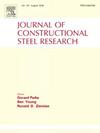火灾条件下钢管混凝土柱的两种建模方法
IF 4
2区 工程技术
Q1 CONSTRUCTION & BUILDING TECHNOLOGY
引用次数: 0
摘要
本文研究了钢管混凝土柱在高温下的高级非线性分析方法。分析了基于广义塑性材料模型(GP模型)的集中塑性单元和基于位移公式的基于纤维的分布塑性梁柱单元两种计算效率较高的方法。GP单元首次用于矩形和圆形截面柱的火灾分析,并将公式扩展到考虑附加钢筋。在可能的情况下,使用这两个元素的应用建模遵循第二代欧洲代码4标准的建议。研究了优化后的截面离散化方法在含纤维单元的非线性火灾分析中的适用性。通过大量的验证研究,将这两种方法的结果与现有的实验和数值结果进行了比较。这种比较不仅包括临界火灾暴露时间的确定,还包括整个力-位移响应的质量、变形形状和计算效率方面的计算。最后,对两种方法的优缺点进行了讨论和总结。本文章由计算机程序翻译,如有差异,请以英文原文为准。
Two approaches for modeling CFST columns under fire conditions
The paper presents a study on the advanced nonlinear analysis of concrete-filled steel tube (CFST) columns at elevated temperatures. Two computationally efficient approaches are analyzed: modeling CFST columns using the concentrated plasticity element based on the generalized plasticity material model (GP model) and using the fiber-based distributed plasticity beam–column element based on the displacement formulation. The GP element is for the first time used for fire analysis of columns with rectangular and circular cross-sections and the formulation is extended to consider additional reinforcement bars. The applied modeling with both elements follows, where possible, the recommendations of the second generation of the Eurocode 4 standard. The applicability of the optimized cross-section discretization schemes in nonlinear fire analysis with fiber element is also investigated. Through extensive validation studies, the results of the two approaches are compared with the available experimental and numerical results. This comparison includes not only the determination of the critical fire exposure time but also the quality of the whole force–displacement response, deformed shape and aspects of computational efficiency. Finally, the benefits and limitations of one approach and the other are discussed and summarized.
求助全文
通过发布文献求助,成功后即可免费获取论文全文。
去求助
来源期刊

Journal of Constructional Steel Research
工程技术-工程:土木
CiteScore
7.90
自引率
19.50%
发文量
550
审稿时长
46 days
期刊介绍:
The Journal of Constructional Steel Research provides an international forum for the presentation and discussion of the latest developments in structural steel research and their applications. It is aimed not only at researchers but also at those likely to be most affected by research results, i.e. designers and fabricators. Original papers of a high standard dealing with all aspects of steel research including theoretical and experimental research on elements, assemblages, connection and material properties are considered for publication.
 求助内容:
求助内容: 应助结果提醒方式:
应助结果提醒方式:


